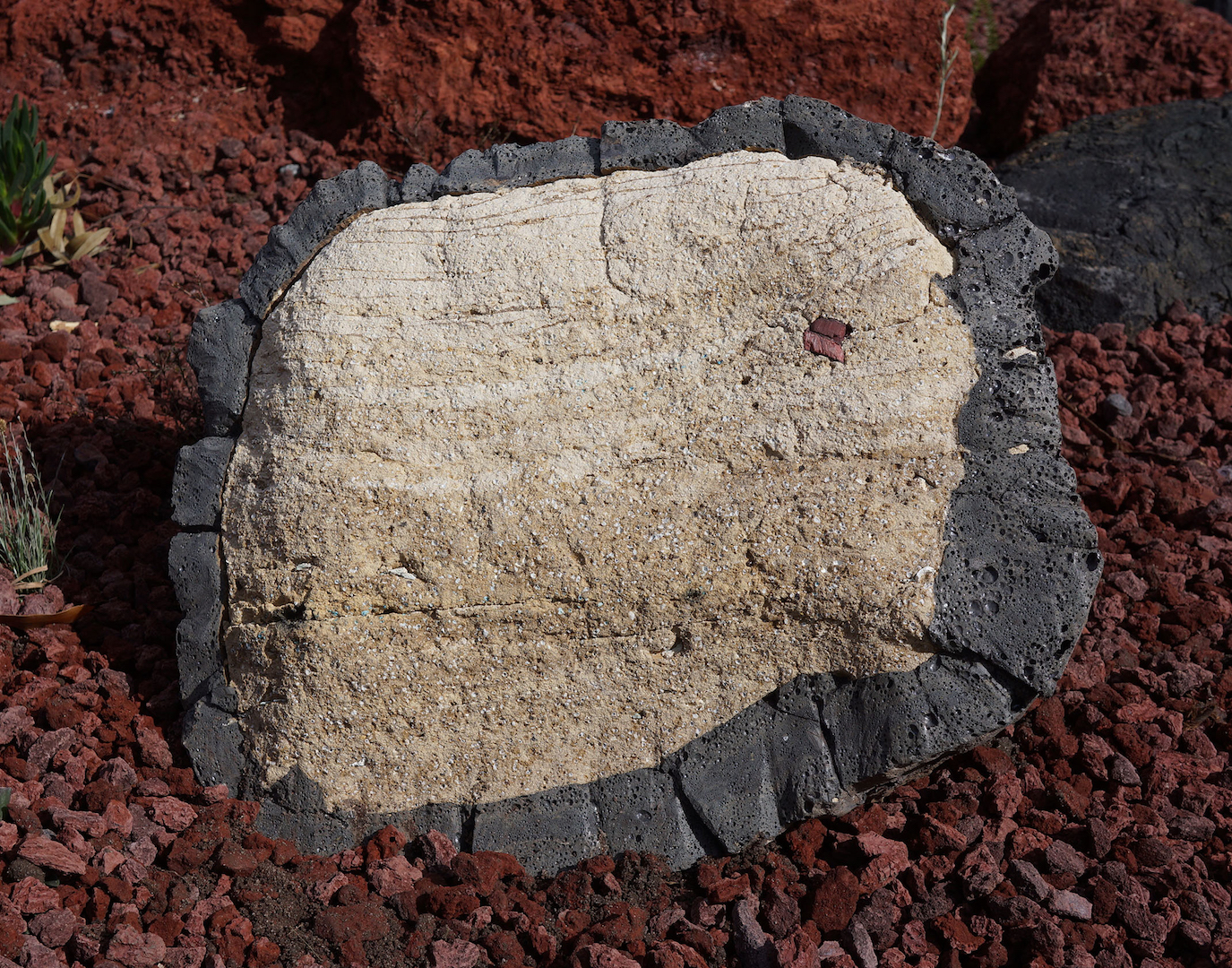Anthropocite is a proposition, a rock type and the narrative of its formation, that speculates on what may result over the coming millennium as a consequence of the mutating relationship between humanity and the earth’s various forces that drive planetary transformations. A video of the narrative can be viewed here.
Building on conversations with Dr Andrew Tomkins, James Driscoll and Julie Boyce, geologists and researchers in the School of Earth, Atmosphere and Environment at Monash University, Professor Nick Birbilis, head of the Department of Materials Engineering at Monash University and Dermot Henry, manager of the Natural Science Collections at Museum Victoria, the research proposes a new rock type called ‘Anthropocite’. The artwork is to be incorporated into the Monash Earth Sciences Garden on the Clayton campus. The work responds to recent critical discussions regarding the effect of human activity on the planet at a global scale. Dramatic changes in atmosphere, accelerated species extinction, extraction and concentration of raw materials, production of new substances and the reshaping of extensive areas of land through building and development have led to the call for a new epoch in geological time scale be recognised. This emerging geological epoch has been termed the ‘Anthropocene’. While the Anthropocene is not currently recognised as a formal geologic epoch it has had widespread discussion within the geological community and is prominent within popular literature. This research explores how the Anthropocene may be evident in rock formations of the future. Through the production of Anthropocite OSW endeavours to think beyond the material detritus that currently surrounds us and to place human activity within a geological time frame.
Material Processes
Following the development of a speculative narrative detailing the formation of Anthropocite, OSW conducted a series of material experiments to investigate the production of lava bombs. This involved both the production of sedimentary rock and volcanic magma. The resulting sedimentary rocks were produced through the layering of graded material, including recycled concrete, asphalt, glass, metal oxides, sands and soil. These layers were stabilized with refractory cement and fired to 1,200 degrees. The volcanic magma was produced through the melting of crushed scoria within a mold around a ceramic core. When combined, these two processes form a ‘volcanic bomb’, a mass of molten rock ejected from a volcano during an eruption. The molten rock encompases a fragment of ‘country rock,’ in the case of Anthropocite sedimentary rock is encapsulated in magma. The cut face of the constructed volcanic bombs reveal the sedimentary layers and magma shell.





in 100 years
Organic matter collects on the roof of the Geosciences building, fouling gutters and composting to form a layer of soil. Seeds dropped by birds and released from surrounding vegetation germinate on the roof and in crevices on the building facade. Roots invade the structure working their way between brickwork and roofing material. Windows are broken by bird impacts. Water regularly floods the building through openings in the roof and windows. Sediment collects in the basement. Water penetrates the concrete. Aggregate expansion in the concrete due to ongoing chemical reactions cause ‘pop outs’ and cracking. Fungus and moulds begin to convert organic fibres in carpets and furnishings into inorganic matter.
in 1,000 years
The building’s roof collapses through the weight of organic matter. Fire due to lightning strikes sweeps through the area converting much of the timber fittings into charcoal. Aluminium, including window frames and suspended ceiling structures, buckle and melt in the fire; window glass is shattered. Brick facades fall forming piles of rubble. Steel rusts to produce iron oxides. Successive layers of rust on steel reinforcing causes mechanical stress that cracks the concrete. Concrete members fail under tension due to corrosion of reinforcing. Concrete beams and floor slabs collapse. Plastics from fittings and furnishings that have been exposed to sunlight break down from UV radiation to form granular polymer material and powder.
in 10,000 years
The building structure has been reduced to rubble. All steel reinforcing has been converted into iron oxides and washed away leaving cavities in the concrete. Aluminium window frames, while initially protected by their coating of oxide, have also corroded to form aluminium oxides. Much of the copper, originally electrical wiring and plumbing has corroded to form copper carbonate. Fungus and moulds have converted all remaining wood and fibre to inorganic minerals. Ceramic fragments from bathroom fittings, while shattered, remain largely unchanged. Loose materials including particles of concrete, plastics, metal oxides, ceramics and glass fragments are continuously washed from the site into neighbouring Dandenong Creek.
in 100,000 years
Material from the Geosciences building have been transported down Dandenong Creek and into the Patterson River. As this material travels it mixes with erosion from surrounding suburbs including asphalt particles from roads. Impacts between particles and with the riverbed break the grains into smaller fragments. These fragments are carried into Patterson Lakes, now submerged under a rising sea, and deposited as sediment on the sea floor. Periodic high intensity rainfall causes flooding of the river system and larger fragments of concrete, rock, glass and asphalt are transported into the bay and deposited on the sea floor. Volcanos in Victoria’s Western Plains continue their intermittent eruptions depositing layers of tephra (fragmented rock in the form of ash and scoria) across large sections of Victoria every 8 - 10 thousand years. These intermittent events cause banding of the sediment strata.
in 1,000,000 years
Strata continue to build as Port Phillip Bay fills with sediment. Early deposits becoming buried under increasing layers of new sediment. Pressure from overburden compacts sediment layers, expelling water from rock pores and promoting the cementation of particles. Particles consolidate into a compact, sedimentary rock. Edge driven convection in the asthenosphere continues to cause intermittent volcanism. As volcanos form, surrounding ‘country rock’, including fragments of sedimentary rock, are carried in the magma flow and ejected in the form of lava bombs, their outer magma surface cooling as they fall to earth.